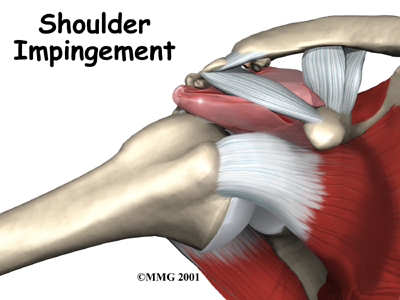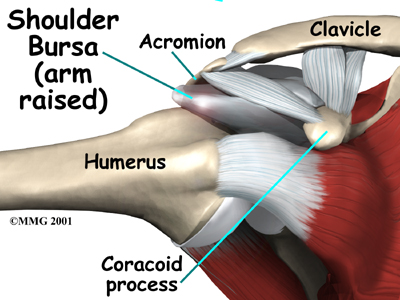Introduction
Physical Therapy in Venice for Shoulder

Welcome to FYZICAL Venice's patient resource about Impingement Syndrome.
The shoulder is a very complex piece of machinery. Its elegant design gives the shoulder joint great range of motion, but not much stability. As long as all the parts are in good working order, the shoulder can move freely and painlessly.
Many people refer to any pain in the shoulder as bursitis. The term bursitis really only means that the part of the shoulder called the bursa is inflamed. Tendonitis is when a tendon gets inflamed. This can be another source of pain in the shoulder. Many different problems can cause inflammation of the bursa or tendons. Impingement syndrome is one of those problems. Impingement syndrome occurs when the rotator cuff tendons rub against the roof of the shoulder, the acromion.
This guide will help you understand:
- what happens in your shoulder when you have impingement syndrome
- what tests your doctor will run to diagnose this condition
- how you can relieve your symptoms.
Anatomy
What part of the shoulder is affected?
The shoulder is made up of three bones: the scapula (shoulder blade), the humerus (upper arm bone), and the clavicle (collarbone).
Shoulder Bones

The rotator cuff connects the humerus to the scapula. The rotator cuff is formed by the tendons of four muscles: the supraspinatus, infraspinatus, teres minor, and subscapularis.
Rotator Cuff

Tendons attach muscles to bones. Muscles move the bones by pulling on the tendons. The rotator cuff helps raise and rotate the arm.
As the arm is raised, the rotator cuff also keeps the humerus tightly in the socket of the scapula, the glenoid. The upper part of the scapula that makes up the roof of the shoulder is called the acromion.
Scapula Socket

A bursa is located between the acromion and the rotator cuff tendons. A bursa is a lubricated sac of tissue that cuts down on the friction between two moving parts. Bursae are located all over the body where tissues must rub against each other. In this case, the bursa protects the acromion and the rotator cuff from grinding against each other.
Bursa

Related Document: FYZICAL Venice's Guide to Shoulder Anatomy
Causes
Why do I have problems with shoulder impingement?
Usually, there is enough room between the acromion and the rotator cuff so that the tendons slide easily underneath the acromion as the arm is raised. But each time you raise your arm, there is a bit of rubbing or pinching on the tendons and the bursa. This rubbing or pinching action is called impingement.
Impingement occurs to some degree in everyone's shoulder. Day-to-day activities that involve using the arm above shoulder level cause some impingement. Usually it doesn't lead to any prolonged pain. But having poor posture, continuously working with the arms raised overhead, repeated throwing activities, or other repetitive actions of the shoulder can cause impingement to become a problem. Impingement becomes a problem when it causes irritation or damage to the rotator cuff tendons.
Raising the arm tends to force the humerus against the edge of the acromion. With overuse, this can cause irritation and swelling of the bursa. If any other condition decreases the amount of space between the acromion and the rotator cuff tendons, the impingement may get worse. For example, poor posture that involves an increased forward curve in the upper back (kyphosis) and rolling inward of the shoulders affects the alignment of the humerus under the acromion. This alters the biomechanics of the shoulder (the ability of the shoulder to move freely and effeciently in space) which means even daily activity such as reaching increases the contact under the acromion.
Bone spurs can reduce the space available for the bursa and tendons to move under the acromion. Bone spurs are bony points. They are commonly caused by wear and tear of the joint between the collarbone and the scapula, called the acromioclavicular (AC) joint. The AC joint is directly above the bursa and rotator cuff tendons.

In some people, the space is too small because the acromion oddly sized. In these people, the acromion tilts too far down, reducing the space between it and the rotator cuff.

Symptoms
What does impingement syndrome feel like?
Impingement syndrome causes generalized shoulder aches in the condition's early stages. It also causes pain when raising the arm out to the side or in front of the body. Most patients complain that the pain makes it difficult for them to sleep, especially when they roll onto the affected shoulder.
A reliable sign of impingement syndrome is a sharp pain when you try to reach into your back pocket. As the condition worsens, the discomfort increases. The joint may become stiffer. Sometimes a catching sensation is felt when you lower your arm. Weakness and inability to raise the arm may indicate that the rotator cuff tendons are actually torn.
Related Document: FYZICAL Venice's Guide to Rotator Cuff Tears
Diagnosis
The diagnosis of bursitis or tendonitis caused by impingement is usually made on the basis of your medical history and physical examination. When you visit FYZICAL Venice our Physical Therapist will ask you detailed questions about your activities and your job, because impingement is frequently related to repeated overhead activities.
Some patients may be referred to a doctor for further diagnosis. Once your diagnostic examination is complete, the Physical Therapists at FYZICAL Venice have treatment options that will help speed your recovery, so that you can more quickly return to your active lifestyle.
FYZICAL Venice provides services for Physical Therapists in Venice.
Our Treatment
Non-surgical Rehabilitation
Whenever possible, it is best to begin by trying nonsurgical treatment. You may be prescribed anti-inflammatory medications such as aspirin or ibuprofen. Resting the sore joint and putting ice on it can also ease pain and inflammation.
Even if you don't require surgery, you may need to follow a program of rehabilitation exercises. When you begin your rehabilitation at FYZICAL Venice, our Physical Therapist can create an individualized program of strengthening and stretching for your shoulder and rotator cuff.
At first, we will use various treatments to calm inflammation, including heat and ice. Our Physical Therapist will also use hands-on treatments and stretching to help restore full shoulder range of motion. Any problems with shoulder and upper back posture will need to be corrected first to improve alignment and shoulder biomechanics. Improving strength and coordination in the rotator cuff and shoulder blade muscles lets the humerus move in the socket without pinching the tendons or bursa under the acromion. Although time required for recovery varies, as a guideline, you may need Physical Therapy treatments for four to six weeks before you get full shoulder motion and function back.
It is important to maintain the strength in the muscles of the rotator cuff. These muscles help control the stability of the shoulder joint. Strengthening these muscles can actually decrease the impingement of the acromion on the rotator cuff tendons and bursa. Our Physical Therapist can also evaluate your workstation or the way you use your body when you do your activities and suggest changes to avoid further problems.
Post-surgical Rehabilitation
Rehabilitation after shoulder surgery can be a slow process. Although the time required for recovery is different for each patient, as a general rule, patients with impingement syndrome usually need to attend Physical Therapy sessions for several weeks, and should expect full recovery to take several months. Getting the shoulder moving as soon as possible is important. However, this must be balanced with the need to protect the healing muscles and tissues.
You may be required to wear a sling to support and protect the shoulder for a few days after surgery. Our Physical Therapist may use ice and electrical stimulation treatments during your first few therapy sessions to help control pain and swelling from the surgery. We may also use massage and other types of hands-on treatments to ease muscle spasm and pain.
Physical Therapy can progress quickly after a simple arthroscopic procedure. Your FYZICAL Venice treatments will start out with postural correction and range-of-motion exercises and gradually work into active stretching and strengthening. You just need to be careful to avoid doing too much, too quickly.
Physical Therapy goes slower after open surgery in which the shoulder muscles have been cut. Our Physical Therapists will usually wait up to two weeks before starting range-of-motion exercises. Exercises begin with passive movements. During passive exercises, we will move your shoulder joint while your muscles stay relaxed. Our Physical Therapist gently moves your joint and gradually stretches your arm. We may also teach you how to do these passive exercises at home.
Active Physical Therapy usually starts four to six weeks after surgery. We will have you use your own muscle power in active range-of-motion exercises. Our Physical Therapist may have you begin with postural correction and light isometric strengthening exercises. These exercises work the muscles without straining the healing tissues.
At about six weeks you start doing more active strengthening. These exercises focus on improving the strength and control of the rotator cuff muscles and the muscles around the shoulder blade. Our Physical Therapist will help you retrain these muscles to keep the ball of the humerus in the socket. This helps your shoulder move smoothly during all your activities.
Some of the exercises you'll do are designed get your shoulder working in ways that are similar to your work tasks and sport activities. Our Physical Therapist will help you find ways to do your tasks that don't put too much stress on your shoulder. Before your Physical Therapy sessions end, our Physical Therapist will teach you a number of ways to avoid future problems.
FYZICAL Venice provides services for Physical Therapy in Venice.